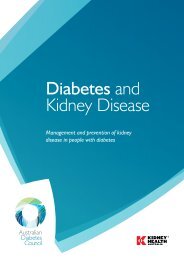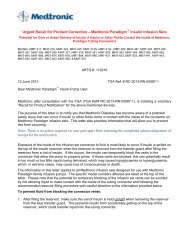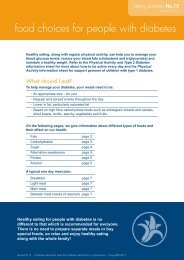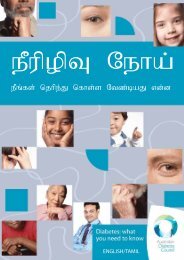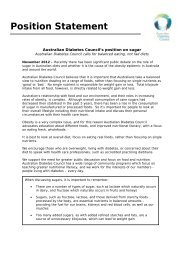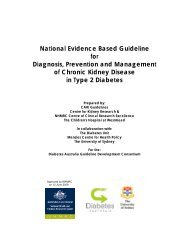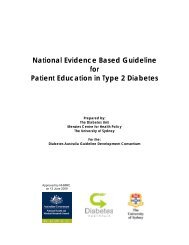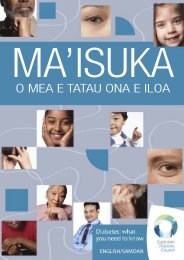Part 6: Detection and Prevention of Foot Problems in Type 2 Diabetes
Part 6: Detection and Prevention of Foot Problems in Type 2 Diabetes
Part 6: Detection and Prevention of Foot Problems in Type 2 Diabetes
You also want an ePaper? Increase the reach of your titles
YUMPU automatically turns print PDFs into web optimized ePapers that Google loves.
people who did not achieve heal<strong>in</strong>g at the end <strong>of</strong> the study <strong>and</strong> 13 people had anosteomyelitis dur<strong>in</strong>g the follow-up. Secondary osteomyelitis developed <strong>in</strong> 3 patients<strong>in</strong> the cast boot group (7%) <strong>and</strong> 13 patients <strong>in</strong> the <strong>of</strong>f-load<strong>in</strong>g shoe group (25%)(p=0.026).However, not all studies have had positive outcomes. Reiber et al (2002a) studied 400people (mean age 62 years) who were r<strong>and</strong>omly assigned to receive 3 pairs <strong>of</strong>therapeutic shoes with cork <strong>in</strong>serts, or 3 pairs <strong>of</strong> therapeutic shoes with prefabricated<strong>in</strong>serts, or assigned to wear their usual footwear for 2 years. At basel<strong>in</strong>e, 58% <strong>of</strong>people were <strong>in</strong>sensitive to the 10g mon<strong>of</strong>ilament <strong>and</strong> 32% had moderate footdeformity. A total <strong>of</strong> 95 reulcerations occurred dur<strong>in</strong>g the 2-year follow-up. Thecumulative reulceration <strong>in</strong>cidence across the 3 groups was similar: 15% <strong>in</strong> the cork<strong>in</strong>sertgroup, 14% <strong>in</strong> the prefabricated-<strong>in</strong>sert group, <strong>and</strong> 17% <strong>in</strong> the control group.People assigned to therapeutic shoes did not have a significantly lower risk <strong>of</strong>reulceration compared with controls - RR was 0.88 (95% CI 0.51-1.52) for the cork<strong>in</strong>sertgroup, <strong>and</strong> 0.85 (95% CI 0.48-1.48) for the prefabricated-<strong>in</strong>sert group.A cohort <strong>of</strong> 352 people with <strong>Type</strong> 2 diabetes were followed over 12 months to assessthe impact <strong>of</strong> footwear on the development <strong>of</strong> foot wounds (Litzelman et al, 1997b).At exam<strong>in</strong>ation at 12 months 63 feet (53 people) had either a blister or wound.Contrary to expectation, a recommendation to wear special footwear was associatedwith <strong>in</strong>creased risk <strong>of</strong> foot wounds at follow up (OR 2.19, CI 1.07-4.49; p=0.03).However the study group was not provided with therapeutic footwear or better accessto therapeutic footwear <strong>and</strong> <strong>in</strong> fact only one person actually wore the special footwear.Edmonds et al (1986) reported the 3-year outcomes <strong>of</strong> a specialised foot cl<strong>in</strong>ic forpeople with diabetes <strong>and</strong> foot ulcers. 239 people with diabetes <strong>and</strong> foot ulcers weredivided <strong>in</strong>to two groups: 148 with palpable pulses <strong>in</strong> the neuropathic group <strong>and</strong> 91without foot pulses <strong>in</strong> the ischaemic group. After <strong>in</strong>itial heal<strong>in</strong>g, 121 people <strong>in</strong> theneuropathic group were observed further, 22 <strong>of</strong> the 86 people (26%) wear<strong>in</strong>g speciallyfitted shoes developed ulceration compared with 29 <strong>of</strong> the 35 people (83%) wear<strong>in</strong>gtheir own shoes (Edmonds et al, 1986).Therapeutic footwear comb<strong>in</strong>ed with podiatry care reduces the risk <strong>of</strong>amputation <strong>in</strong> high risk <strong>in</strong>dividualsProtective footwear was <strong>of</strong>fered to a group <strong>of</strong> high risk people with neuropathy,previous ulceration, vascular <strong>in</strong>sufficiency (ABI ≤0.75) <strong>and</strong>/or foot deformity, <strong>in</strong> aRCT <strong>of</strong> a diabetic foot screen<strong>in</strong>g <strong>and</strong> protection programme (McCabe et al, 1998). Atotal <strong>of</strong> 2,001 people with diabetes were <strong>in</strong>cluded <strong>in</strong> this study <strong>and</strong> were r<strong>and</strong>omlyallocated to the <strong>in</strong>dex group (n=1,001) or the control group (n=1,000). 128 peoplewith a high risk <strong>of</strong> ulceration <strong>in</strong> the <strong>in</strong>dex group were recruited to a protectionprogramme which provided podiatry sevices <strong>and</strong> protective footwear. At 2-yearfollow-up, there were 24 ulcers <strong>in</strong> the <strong>in</strong>dex group compared with 35 ulcers <strong>in</strong> thecontrol group. Moreover, less ulcers progressed to amputation <strong>in</strong> the <strong>in</strong>dex group (7, 1major <strong>and</strong> 6 m<strong>in</strong>or) compared with 23 amputations <strong>in</strong> the control gropu (12 major <strong>and</strong>11 m<strong>in</strong>or). The difference <strong>in</strong> the total number <strong>of</strong> amputations between the two groupswas significant (p




